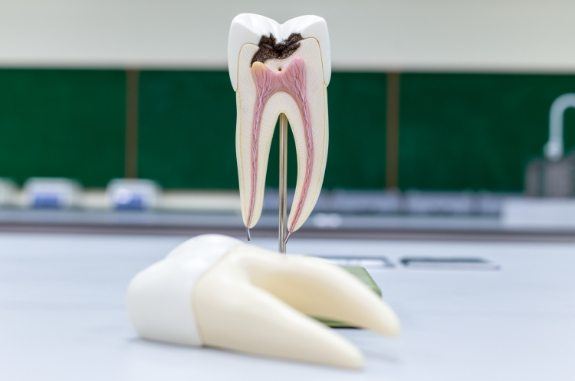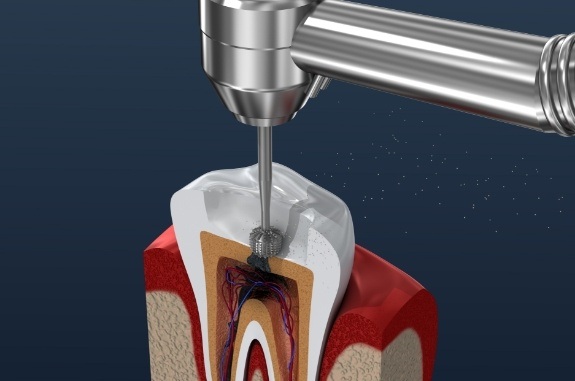Root Canal Treatment – Clute, TX
Save Infected Teeth from Extraction
A root canal is often thought of as an extremely complicated procedure that can also lead to tooth loss. If you need root canal treatment, it’s an indication that your gum disease has spread deep into your tooth. But a root canal procedure isn’t very complicated, and it can help you avoid tooth loss. This is often a last resort procedure to prevent complete tooth loss. Call us and let us know if you are experiencing pain that might signal the need for root canal treatment in Clute.
Why Choose Woodshore Family Dentistry for Root Canal Treatment?
- Multiple Options for Relaxing Dental Sedation
- State-of-the-Art Dental Technology
- Most Dental Insurance PPOs Accepted
What Are Root Canals?

To understand what a root canal is, you need to understand the basic anatomy of a tooth. The outer layer of the tooth is the enamel. Within that lies the dentin. And finally, beyond the dentin layer lies a soft tissue called the pulp. This pulp reaches from the crown to the roots of the tooth, and it also contains the blood vessels, nerves, and other connective tissues of the tooth. A root canal is thus the entire structure that contains the pulp, nerves, and blood vessels.
What Is Root Canal Treatment?

Root canal treatment is a procedure that becomes necessary when your root canal is infected. If you’re suffering from a bacterial infection or dental infection, it’s necessary to see a doctor immediately so they can treat the infection before it spreads deep into your tooth. If you don’t treat the disease in time, the bacterial infection can spread to your pulp chamber. This leads to an abscessed tooth (i.e., pus forms inside the tooth). When this happens, you can suffer from severe swelling and bone loss. If you don’t treat it in time, the entire tooth can get infected, and you may even suffer from tooth loss. Root canal treatment is a procedure in which the dentist enters the root canal or pulp chamber and completely removes all of the infected pulp, nerves, and blood vessels. It’s safe to remove these nerves because they’re only responsible for conveying hot and cold sensations, which will leave your tooth a little sensitive. By completely emptying the pulp chamber and cleaning it, the dentist can prevent the infection from spreading further.
Signs That You Need Root Canal Treatment

The necessity for an emergency root canal treatment means you’ve probably ignored several of the signs and symptoms of bacterial infection already. You must be vigilant about a few signs that indicate you need an emergency root canal treatment, or else it may be too late to save your tooth. The following are some of the signs to watch out for:
- Excessive pain sensation in your teeth when you eat or chew your food.
- Pimples formed around your gums.
- Cracked or fractured teeth.
- Your teeth feel extremely cold or hot and are very sensitive to temperatures.
- Swollen or inflamed gums.
- Gums that bleed easily when you brush your teeth.
- Formation of deep cavities in your teeth.
What Are the Benefits of a Root Canal?

The following are some of the primary benefits of root canal treatment:
- It’s not extremely complex or invasive. The entire procedure is similar to getting dental fillings for your cavities.
- It gets rid of the infection completely and prevents it from spreading.
- It helps you avoid complete tooth loss.
The Root Canal Procedure

The root canal treatment can be handled by a dentist or endodontist, and it may take a few sessions depending on the spread of infection. An emergency root canal procedure involves these steps:
- The dentist or endodontist takes an X-ray of your teeth to see if your bones are infected.
- While it’s not necessary to use anesthesia because the nerves in the infected tooth will be dead anyway, most dentists will still apply anesthesia so there’s not even a remote possibility of you feeling any pain.
- The dentist or endodontist will also place a rubber dam. This will prevent your saliva from interfering with the procedure.
- The dentist or endodontist will excavate the tooth to reach the pulp chamber. They’ll remove all of the infected pulp along with the dead nerves and blood vessels. This procedure will also include several root canal files with which the dentist will drill into the cavity and clean it out. Water or sodium hypochlorite may be used to remove the remaining debris.
- The next step in the root canal procedure is sealing the tooth. In some cases, the dentist or endodontist may seal the tooth immediately. However, in other cases, the dentist or endodontist will simply apply some medicine to deal with the infection and ask you to return after a week. In this case, the dentist will also place a temporary filling to protect your tooth from external impurities.
- Once your tooth is ready to be sealed, the dentist or endodontist will apply a sealer paste and a material called gutta percha. This will seal the insides of the hollow tooth. The outer part of the tooth will be sealed with tooth-colored materials like porcelain, ceramic, or composite resin.
- After the root canal treatment, your tooth is likely to be fairly weak. As such, the dentist or endodontist may recommend you get a dental crown to protect it from further damage. In this case, the dentist will simply place a porcelain or ceramic cap over your existing tooth to conceal and protect it.
I Need a Checkup & Cleaning I Need a Dentist for My Child I am Worried About Gum Disease I Have a Cavity or Broken Tooth I am Missing One or More Teeth I Want to Enhance My Smile I Want a Straighter Smile I am Concerned About Sleep Apnea I am Scared of the Dentist I Have Pain in My Jaw I Have a Dental Emergency View Our Services


